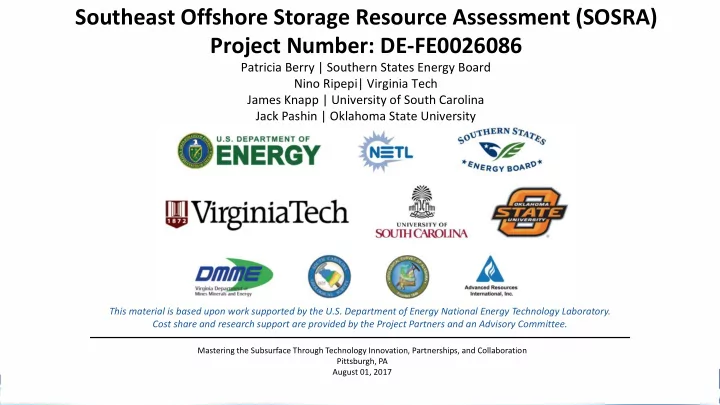

Southeast Offshore Storage Resource Assessment (SOSRA) Project Number: DE-FE0026086 Patricia Berry | Southern States Energy Board Nino Ripepi| Virginia Tech James Knapp | University of South Carolina Jack Pashin | Oklahoma State University This material is based upon work supported by the U.S. Department of Energy National Energy Technology Laboratory. Cost share and research support are provided by the Project Partners and an Advisory Committee. Mastering the Subsurface Through Technology Innovation, Partnerships, and Collaboration Pittsburgh, PA August 01, 2017
SOSRA • Southeast Offshore Storage Resource Assessment Managed by the Southern States Energy Board (SSEB) SSEB appointed three planning area managers to each offshore region (Eastern GOM, South Atlantic, Mid-Atlantic) Geologic characterization of offshore storage opportunities Static volumetric assessment of storage capacity using NETL methodology 2
Decision Making & Communications Advisory Committee : state geological surveys, universities, state oil and gas boards, oil and gas companies, and utilities (no contract, no decision making authority)
SOSRA Project Timeline 3/2018 Geologic Characterization and 3/2016 3/2017 Volumetric Calculations Geologic Data Analysis Completed Overview 3/2015 10/2018 10/2015 Completed (Task 5.0) Completed Proposal PROJECT PROJECT (Task 4.0) (Task 2.0) Submitted ENDS BEGINS 2015 2016 2017 2018 GO/NO-GO 9/2018 9/2016 DECISION Best Practices, NATCARB and Data POINT Atlas, Outreach, Closeout Collection 8/2015 and Reporting Completed Project Completed (Task 3.0) Awarded (Tasks 6.0, 7.0, 8.0, 9.0) GO/NO-GO DECISION POINT: The data collected and analyzed in Phase I is sufficient to perform a quality prospective storage resource assessment and the project should proceed to Phase II. Note: Task 1.0, Project Management and Planning, extends throughout the entire program period.
Summary – SOSRA
EGOM Study Area and Subregions DCSB DeSoto Canyon Salt Basin MGA Middle Ground Arch TE Tampa Embayment SA Sarasota Arch SFB South Florida Basin
Geothermal and Burial Data, DCSB Temperature-depth profile Burial history curve
Normal Brine, Pressure Gradients, Onshore Eastern Gulf TDS-depth plot Pressure-depth plot 400,000 14,000 350,000 12,000 0.54 psi/ft 300,000 10,000 250,000 Pressure ( psi) TDS ( m g/ L) 8,000 200,000 y = 0.23x 1.08 y = 21.81x R² = 1.00 R² = 0.86 6,000 150,000 4,000 100,000 2,000 50,000 0.44 psi/ft 0 0 0 5,000 10,000 15,000 20,000 0 5,000 10,000 15,000 20,000 25,000 Depth ( ft) Depth ( ft)
Seismic Velocity Surveys One-Way Travel Time (ms) 0 500 1000 1500 2000 2500 0 5000 Depth of investigation 10000 Depth (ft) West FL 15000 DCSB Geopressure 20000 25000
DCSB Destin Dome
Depth-Converted Structural Cross Sections, DeSoto Canyon Salt Basin Destin Dome Salt Roller Province
Top Ferry Lake Anhydrite
West Florida Shelf Bathymetry • Broad, shallow, region near shore (NE of 80 m contour). • Distally steepening outer shelf leading to West Florida Escarpment.
Data Quality – West Florida West East TWT (s) Upper Slope Rise Escarpment 0 1 2 Detail imaged at escarpment and 3 toe of slope 4 Platform imaged far beyond 5 Ancient shelfbreak imaged depth of investigation 1 km
Prospective EGOM Sinks
South and Mid-Atlantic Planning Areas Total of six exploration wells, on Georgia/Florida shelf Major depocenters in Carolina Trough and Blake Plateau Basin
Prospective Mesozoic Section Chadwick et al (2008) Scholle (1979)
Upper Cretaceous Prospective Sink Flat-lying, regionally extensive, structurally uncomplicated thick stratigraphic section Significant porosities (15-30%) and permeabilities (3.5-450 mD) within interbedded clastic and carbonate rocks Appropriate depths (4,000-6,000 ft.) for CO 2 storage Almutairi et al (in prep)
Data Coverage — Mid-Atlantic Planning Area Over 1,000 lines and 34 wells (only 5 offshore) were selected for the study of the Mid-Atlantic Region. Areal Coverage Method: Line/grid Spacing: Regional, Semi- Regional, Exploration scale Location of offshore wells outside the study area. Presence of 5 exploration wells at the North of the region. Results: Unlike the sparse distribution of well data, the seismic data collected on the Mid-Atlantic margin is of sufficient density to perform the interpretation task. 19
Quality Analysis Over 1,000 lines and 34 wells (only 5 offshore) were selected for the study of the Mid-Atlantic Region. Quality Assessment Method: Resolution: frequency analysis, data stacked or migrated Survey Design: source volume and cable length Benefit of reprocessing: identify lines of poor quality and potentially reprocess if needed Results: The quality varies from fair to poor and is better for more recent data. Offshore wells were QC’d to improve their quality.
Seismic Interpretation – Cretaceous Sinks
Concluding Thoughts • Giant potential for offshore CO 2 storage. • Large portfolio of potential sinks and seals in eastern Gulf and Atlantic regions. • Seismic and well data being interpeted. • Geopressure >12,000 ft; main storage prospects in Cretaceous-Miocene section. • High porosity reservoirs identified in sandstone and carbonate; seals include mudrock, chalk, and evaporites. • Pristine reservoir potential represented by much of the southeast offshore.
Recommend
More recommend